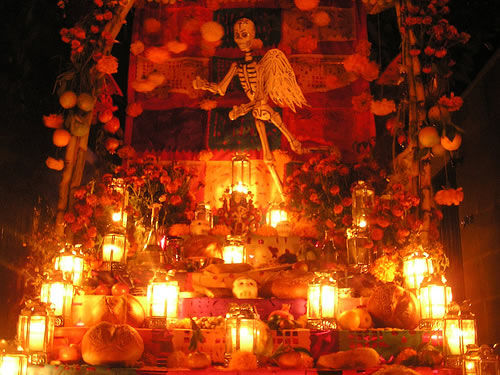Day of the Dead in Oaxaca, Mexico
A Sacred Celebration Combining Indigenous and Catholic Traditions
Article and photos by Ron Mader
Latin America Correspondent and the Responsible Travel
Contributing Editor
Day of the Dead (Dia de los Muertos) is an annual celebration that manifests
a rich blend of Catholic and indigenous traditions.
Spirits of the beloved dead return to their homes and visit for a short time
with their families and friends. The first day of November the souls of
departed children arrive, and on the second day of November they are joined
by spirits of adults. Like all visitors, they are welcomed with food, drink,
stories, memories, and good will. Their presence is thought of as a blessing
rather than a curse, and brings joy to their loved ones.
In preparation for this celebration, the last days of October are spent
preparing special loaves of sweet bread (pan de muerto), and desserts;
making mole, harvesting special
flowers, including marigolds (cempasúchil); creating altars in the home and
decorating grave sites. Decorations in the form of macabre but whimsical
skeletons and candy skulls abound. Death is not to be feared but embraced.

|
Oaxaca City — Day of the Dead altar made by Boris Spider.
|
Oaxaca lays claim to having one of Mexico's richest Day of the Dead
traditions and the number of visitors spikes after an autumn lull.
There are some fine overviews of the holiday including Transition Abroad's essay Honoring Tradition and Planeta.com's Celebrating Day of the Dead in Mexico. That said,
how does one participate? Here we present some of the activities open to the
public.
Markets
All of Oaxaca's markets are fully operating in the days prior to the Muertos holiday. They provide the decorations for the altar including the
candy skulls, skeletons, and ceramic figures. One of our favorite markets is
the Pochote in
Colonia Xochimilco. On Friday November 1 and Saturday November 2 the market
will feature select crafts and foods. It is also a prime venue to learn
about places to visit over the next few days.
Responsible Travel Photography
Travelers have no better proof that one has made a journey than by taking a
photo. But when is taking a picture offensive to others?
Many locals welcome photographers, but if you want to do things right, ask
permission. Put yourself in the shoes of those you are
visiting. Would you want strangers to take your photo without your consent?
And if you take photos that locals request, you are practicing
the platinum rule which I define as treating others the way they wish to be treated. If you take photos of individuals,
give them a print copy or send the photo to them via email. For more tips see my Responsible Travel Photography article written for Transitions Abroad.
|
Ron
Mader is a Transitions Abroad Latin America correspondent and host of the Planeta website.
|
